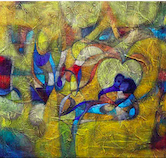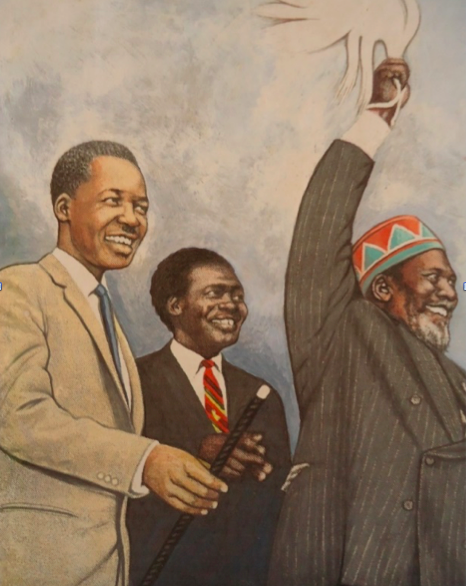Tanzanian modernism emerges from heterogeneous, locally rooted modernisation processes and an African interpretation of global modernisms and modernities.
![[FIG 01] Edward Saidi Tingatinga, Peacock, 1972, courtesy Eaman Collection](https://eaman.belvadigital.com/wp-content/uploads/2024/08/Unit-1_FIG-01_Edward-Saidi-Tingatinga-peacock_1972_-Eaman-Collection.jpg)
TANZANIA’S ARTISTIC MODERNISATION PROCESSES ARE NON-LINEAR AND MODERNISM EMERGES IN VARIABLE CONVERGENCES OF FOREIGN AESTHETICS, RELIGIOUS, POLITICAL AND PHILOSOPHICAL TRENDS AND TRANSREGIONAL ARTFORMS, SUCH AS MAKONDE AND TINGA TINGA.
East Africans’ benign and hostile intercultural exposures to other continental cultures both have had a noticeable effect. Tanzanian modern art, its origins, and layered complexities shows parallels to developments in other parts of Africa, which can be traced in the existing scholarship on West African art. In addition recent scholarship not only highlights the interconnectedness of European modernisms with continental African archeological finds and modern African art practices (Cohen, 2020), but it rightly troubles the dominant narratives about the origins of modernism, which place Europe as its epicenter (Arnold, 2008:1).
Modern Tanzanian art does not follow a linear timeline nor is its progress marked by schisms generating new artistic movements in the sense of a global modernism, such as the European stylistic movements of Impressionism or Cubism. In East Africa several artistic formations emerged under the label of modernity, but these hardly shared uniform visual characteristics. The artistic heterogeneity is particular and distinct from musical modernisation for example. Rhumba, which originated in cosmopolitan Congo in the 1940s and 50s, spread with local variations throughout continental Africa and was perceived as a pan-African post-Independence music of liberation (White, 1998, 2002 and Perullo, 2008). Modern art in East Africa on the other hand resonates the continuity of local roots as well as reflecting the lasting impact of multiple foreign contacts. Local roots of origin for modern art tendencies include references to the oldest known prehistoric rock art found in many parts of Tanzania. These origins of many forms of modern art in Africa are not well documented in literature. There is little scholarship about the traces of this significant prehistoric art; yet, it should be explored more as a source of inspiration for Tanzania’s modern art movement. In the nineteenth century the contacts with the Middle East and Asia were most intense, particularly with Arabs from Oman and Persians who annexed the East African coastline in the 1840s (Iliffe, 1979).
TO GRASP THE COMPLEXITIES OF MODERN ART IN EAST AFRICA, IT IS ESSENTIAL TO ACKNOWLEDGE THESE ENTANGLEMENTS WITH LOCAL ROOTS AND MULTIPLE FOREIGN MODERN ART PRACTICES AND CONCEPTS FROM THE NINETEENTH CENTURY ONWARDS IN ADDITION TO THE IMPACT OF A EUROPEAN LED COLONIAL RESTRUCTURING OF ART EDUCATION IN THE TWENTIETH CENTURY.
A shared characteristic of modern art with local roots produced in many parts of Africa is its secularism and strong ambivalence to lived traditions. This ambivalence is a recurring feature despite the continued use of traditional media and, in most instances, similar aesthetics to traditional art genres. Over time this aesthetic is further reconfigured in conversation with global artistic techniques and foreign media, resonating imported elements as a result of Islamisation and Christianisation from as early as the 9th century and of later colonisation by Germany in 1880, followed by Britain in the 1920s.
The British Indirect Rule System in Tanganyika strongly impacted on the education system, which after the subsequent declaration of Independence in 1961 and the unification with Zanzibar in 1964 began to unravel. Tanzania’s ideological experimentation from 1967 following the Arusha Declaration and the country’s adoption of Ujamaa (family hood/brotherhood) up to the economic crises of the 1980s further shaped the country’s artistic creations and endeavors. Ujamaa as a form of African Socialism practiced in Tanzania is a formal political and economic strategy from 1967 until the early 1990s. Although it has several governance features in common with socialist policy structures in the northern hemisphere, such as state control over production systems and one-party rule, Nyrere’s governance was less of a rigid political structure and more of compassionate administrative practice. Thus Tanzania’s modern works of art reflect the extreme freedoms of expression of individual artists afforded through the adoption of Ujamaa as well as traditional values.
![[FIG 02] Ali Darwish, Allah Akbar, oil painting, 1978, Courtesy of MITSFA Art Gallery Kampala, Uganda 2015](https://eaman.belvadigital.com/wp-content/uploads/2024/08/Unit-1_FIG-02_Ali-Darwish_Allah-Akbar_oil-painting_1978_Courtesy-of-MITSFA-Art-Gallery-Kampala_Uganda-2015-1.jpg)
The earliest groups of foreigners to visit the coasts of Tanganyika to spread their civilization, specifically Islamic religion and cultural values were the Arab-Persian traders, who settled at Kaole in Bagamoyo, Tanganyika, in the 9th century (Iliffe, 1979, Swantz, 1986, and Mshana, 2023). Later settlements are at Kilwa-Kisiwani, the center for the medieval Kilwa sultanate and, subsequently, the Islands of Zanzibar. In 1696 Saif bin Sultan successfully defended the East African coast against Portuguese forays. In the late 19th century European Christian missionary groups consisting of the Lutheran, Anglican, and Roman Catholic crusaders concentrated their campaigns on the mainland (Iliffe, 1979). In the promotion of their religions, Christian missionaries employed illuminated and illustrated bibles with images of figurative naturalism to entice African conversions (Mbiti, 1958). The Islamic crusaders meanwhile had introduced non-figurative calligraphic art in their manuscripts. Calligraphic art became socially and culturally integrated and popularly used in banners, murals, paintings, house address markers as well as copies of the Qur’an and religious attires such as scarves and prayer mats (Baker, 2004) [FIG 02].
SINCE THE INCEPTION OF ISLAMIC BELIEF, CALLIGRAPHY HAS SPREAD, BECOME ADOPTED, AND ADAPTED AMONG ISLAMIC CONVERTS AND ARTISTS WHO INHABIT THE COASTAL REGIONS OF TANZANIA SPECIFICALLY AND EAST AFRICA GENERALLY (SWANTZ, 1986).
![[FIG 03] Zanzibar Door (Source: Missy and the Universe, April 2009)](https://eaman.belvadigital.com/wp-content/uploads/2024/08/Unit-1_FIG-03_Zanzibar-Door_Zanzibar-Stone-Town_Photograph-Lori-Greene-2023.jpg)
In addition to the importance of calligraphy, Nooter (1984) refers to the decorative Zanzibar doors [FIG 03], as some of the most popular works of modern art. These were inspired by the arrival of Arab-Persian traders in Zanzibar and several other coastal towns in Tanganyika, such as Mikindani, Kilwa, Bagamoyo, and Pangani. According to Nooter (1984), the Zanzibar door art, also known as the Swahili doors, emerged in Zanzibar in the mid-19th century. Their early productions can be linked to Sultan Seyyid Barghash’s commissions. The doors were initially made for the Sultan and wealthy Indian and Arab-Persian merchants but, later on, more artists created them and gradually commoners could also afford to buy them.
![[FIG 04] Daudi Hyera, Unnamed Ugandan Martyrs, high relief cement sculpture, 1960s](https://eaman.belvadigital.com/wp-content/uploads/2024/08/Unit-1_FIG-04_Daudi-Hyera_Unnamed-Ugandan-Martyrs_high-relief-cement-sculpture_1960s_Likonde-Seminary_Photograph-Dominicus-Makukula-_August-2023-.jpg)
![[FIG 05] Daudi Hyera, Unnamed Ugandan Martyrs, high relief cement sculpture, 1960s (Photograph by the researcher at the Likonde Seminary, August 2023)](https://eaman.belvadigital.com/wp-content/uploads/2024/09/Unit-1_FIG-05_Daudi-Hyera_Unnamed-Ugandan-Martyrs_high-relief-cement-sculpture_1960s_Likonde-Seminary.jpg)
Christian evangelisation’s extensive use of 2D illustrations and to a lesser extent sculptures based on biblical themes, triggered several modern art genres by local artists in Tanzania from the 1860s onwards (Mshana, 2023). High-relief sculptures made on church walls, low-relief clay slabs, carved doors (furniture), murals, and paintings were among the works of art created in new churches all over Tanzania [FIGs 04, 05]. Between the 1930s and the late 1980s, Daudi Hyera, an autodidactic artist based in Mbinga district, Ruvuma region, created hundreds of religious pieces that were commissioned and financed by Catholic churches in most parishes in the south and southern highland regions of Tanzania.
The impact of religious missioning contributed strongly to the emergence of modern art practices, but on the flipside Islamisation and Christianisation actively discouraged the development and use of traditionally diverse regional Tanzanian art for ancient belief systems and customary fertility and burial rituals. This is evident in the decline of the production and use of the Mwanahiti fertility dolls and carved grave posts among the Wazaramo after Lutheran and Catholic missions were installed at the Maneromango area, Pwani (Coast) region in Tanzania.
Similarly, a Wangoni ancestors’ shrine at Peramiho, adorned with hundreds of arts and religious objects pieces, was gutted by a German priest, who dismissed the sacred site as a pagan shrine (Makukula, 2022).
HOWEVER, A POSITIVE EFFECT OF CHRISTIANISATION BY WHITE MISSIONARIES AT NDANDA MISSION IN MTWARA REGION WAS, THAT IT INSPIRED THE WAMAKONDE CARVERS, WHO IGNORED THEIR TABOOS AND EMBARKED ON CREATING MODERN ART PIECES BASED ON THE MAKONDE SACRED SPIRITS THEMES
[FIG 06]. The secular Makonde sculpture production that boomed from the 1950s onwards is associated with the effects of Christian evangelisation in the current research. Christianisation in many parts of Africa suppressed African religious belief systems, which the missionaries dismissed as inferior and barbaric (Mbiti, 1968).
![[FIG 06] Martin Legu, Tengamatu, 1969, a hybrid Shetani sculpture, Courtesy of Karibu Art Gallery, Dar es Salaam](https://eaman.belvadigital.com/wp-content/uploads/2024/09/Unit-1_FIG-06_Martin-Legu_Tengamatu_1969-hybrid-Shetani-sculpture_Courtesy-of-Karibu-Art-Gallery_Dar-es-Salaam.jpg)
![[FIG 07] Daudi Hyera, Kigonsera Cathedral (southern view), July 1943, acrylic on canvas, Photograph by researcher at Kigonsera, Mbinga August 2023](https://eaman.belvadigital.com/wp-content/uploads/2024/08/Unit-1_FIG-07_-Daudi-Hyera_The-Kigonsera-Cathedral-southern-view_-1943_Acrylic-on-Canvas_The-Kigonsera-Chapels-Rectory-.jpg)
However, these developments made newly created modern African arts on religious themes more controversial, in both, the essence of their derivation and their current social functions. Overall, the Islamisation and Christianisation campaigns by foreign missionaries since pre-colonial times had profound effects on the inception and promotion of modern African art.
Miller (1975), Kasfir (1999), Makukula (2019) and Mshana (2023) present overwhelming evidence which attests to the contribution of foreign religious relics and educational materials such as banners, books, and illustrations in inspiring and shaping the characteristics of modern African art, produced by autodidactic artists in Tanzania. Techniques and practices as displayed in the illuminated Bibles and other European sacred books were adapted in the creation of modern art by autodidactic artists. The illustrations’ style of naturalist figuration became the canon of civilization for the incoming colonial art education into the mid-twentieth century. Moreover, some European missionaries who were interested in the arts patronized the talents of their new converts who, in their mind, showed artistic prowess. One such example is Daudi Hyera’s lightly impressionistic realism in his depiction of the Kigonsera Cathedral [FIG 07], painted in July 1943. Records on exhibitions mounted at the National Museum of Tanzania in Dar es Salaam since the 1930s show that Daudi Hyera was apprenticed into painting and sculpture by Fr. Werner, an internationally well-travelled German priest and passionate art collector and promoter.
![[FIG 08] Harun Bomera, WWI](https://eaman.belvadigital.com/wp-content/uploads/2024/08/Unit-1_FIG-08_Harun-Bomera-WWI-Germans-surrender-to-the-British-at-Abercorn-Tanganyika-on-November-25-1918_Painting-attr-1920s_Courtesy-of-the-National-Museum-of-Tanzania_Dar-es-Salaam_Oct-2023.jpg)
![[FIG 09] Joseph Nyunga, Kimbunga, Shetani Sculpture, undated, Photograph by researcher, CHAG Arusha, 2017](https://eaman.belvadigital.com/wp-content/uploads/2024/09/Unit-1_FIG-09_Joseph-Nyunga_Kimbunga_Shetani-Sculpture_undated_Photograph-Dominicus-Makukula_CHAG-Arusha-2017.jpg)
There is neither textual nor image evidence to attest to the emergence or growth of modern African art during the initial years of colonialism in Tanganyika, which had been part of German East Africa, which also included present-day Burundi and Rwanda. Research conducted on art education revealed that German colonialists had no art programmes for Africans in their schools (Msangi, 1987 and Mwenesi, 1998).
Despite the presence of strong artistic traditions in painting and sculptural arts, German colonialists had no interest in promoting local artists and arts (Arnold, 2008). Karl Weule describes panoramic-semi abstract murals depicting wild animals and humans he saw during his expedition in areas presently known as the Lindi, Mtwara, Ruvuma, and Njombe regions (Weule, 1903). The German colonial establishment barred Africans from engaging in creative and recreational activities (Iliffe, 1979). This changed when the British took over Tanganyika as its protectorate in 1919 under the indirect rule system of governance (Iliffe, 1979). Indirect rule guaranteed the British colonialists some amount of acceptance by the Tanzanians in the colony and consciously afforded some partial freedoms of association and opportunities for locals to engage in creative activities such as art production
It was during this period that several auto-didactic Tanzanian artists emerged. Their early works were initially reconfigurations of European techniques found in works of art published in books and newspapers.
ACCORDING TO BASATA (BARAZA LA SANAA LA TAIFA= SWAHILI FOR NATIONAL ARTS COUNCIL, 1984), HARUN BOMERA IS PROBABLY ONE OF THE FEW POPULAR ARTISTS IN TANGANYIKA TO ADOPT AND ADAPT MODERN PAINTING TECHNIQUES ON MEDIA SUCH AS WATER, AND OIL PAINTS ON CANVAS SINCE THE EARLY 1920S [FIG 08].
The reductive anatomy of human figures of the Askari soldiers, as well as the irreconcilable proportions of the trees, the car, the horse in his painting confirm Bomera’s auto-didactic stylistic characteristics, which are coupled with his unique monochromatic painting skills.
The freedom of association among Africans, Europeans, Arab-Persians, and Indians, did not only allow auto-didactic artists to blossom but also inspired the emergence of Tanzanian art dealers among European, Arab, and Indian settlers. In the early 1950s, Mohamed Peera, an Indian art dealer opened a curio shop specialising in selling Makonde carvings and crafts to tourists and foreign art collectors (Ntiro, 1982). As his small shop expanded into a big business Peera created a production workshop where he gathered the best self-taught and talented Makonde master carvers under his patronage (Miller, 1975) [FIG 09].
IN 2009 ELIAS JENGO CREDITS MOHAMED PEERA’S WORKSHOP WITH HAVING STIMULATED AND SUPPORTED EIGHT DOMINANT MODERN MAKONDE SCULPTURE GENRES: THE BINADAAM, SHETANI, MAWINGU, DIMOONG’O (LATER RENAMED UJAMAA), MANDANDOSA, KIMBULUMBULU, GILIGIA, AND TUMBATUMBA.
These genres were invented under Peera’s patronage between the 1950s and the 1960s, with Shetani as the most widely acclaimed Makonde sculpture genre.
![[FIG 10] Chanuo Maundu Shetani](https://eaman.belvadigital.com/wp-content/uploads/2024/08/Unit-1_FIG-10_Chanuo-Maundu_Shetani-Figure_Undated_Salim-Lilani-Collection_Photograph-Zachary-Kingdon-and-Muhunyo-Maina_2024-scaled.jpg)
Despite its controversial contribution to the emergence of modern art in Africa as observed by Msangi (1987), Mwenesi (1998), and Okeke (2004), colonial education had to some extent laid a strong foundation for modern African art movements and practices that blossomed in many parts of the continent.
In Tanzania, for example, the pioneers of modern art such as Abdallah Farahani, Waziri Juma, Sam Joseph Ntiro, Sefania Tunginie, Lekyaelimoo [Elimo] Njau, Kiure Francis Msangi and Elias Eliezer Jengo [FIG 10], had acquired their formal training from elementary to tertiary education level before they started practicing as seasoned artists and art educators in Tanzania and neighbouring East African countries in the 1950s onwards (Miller, 1975). In particular, the Tanga School included art programmes in its training in the 1940s whereas Ifunda Technical College and Butimba Teachers’ Training College had art programs as part of their curriculum since their inception in the 1950s and 1960s. (Makukula, 2019) Some elements of European modern art styles such as Impressionism, Expressionism, Cubism and Dadaism, are reconfigured in the works of these modern Tanzanian artists serve as evidence of the influence of formal training that most of them had acquired. Significantly, the Makerere School of Art in Kampala, Uganda under Cecil Todd was instrumental in promoting canonical modern art practices to African students enrolled in its art programme (Miller 1975, Kasfir 1999 and Kyeyune, 2008).
SINCE THE 1950S AND 60S, FORMALLY TRAINED ARTISTS FROM THE MAKERERE SCHOOL OF ART SERVED AS ART EDUCATORS, CURATORS, ADMINISTRATORS, AND COMMISSIONERS IN THEIR RESPECTIVE COUNTRIES AND STRONGLY INFLUENCED THE GROWTH OF MODERN ART PRACTICES (NYACHAE, 1995).
Sam Ntiro, for example, left a significant mark on the modern art scene in Tanzania for his contribution to the establishment of the Department of Art at the University of Dar es Salaam and other art training programmes in the country’s schools and colleges.
![[FIG 11], Elias Jengo, Untitled, painting, 1990s, Courtesy of Karibu Art Gallery, October 2023](https://eaman.belvadigital.com/wp-content/uploads/2024/08/Unit-1_FIg-11_Elias-Jengo-_-Wakulima_1969_courtesy-Eaman-collection-1.png)
The most significant contribution worth noting about the country’s independence to the emergence of modern Tanzanian art is, of course, the enrichment and extension of the local aesthetic standards formulated and promoted through the endogenous discourse. Independence in African countries significantly impacted the movements and themes produced in modern African arts created during and on the eve of the event (Enwezor and Okeke, 2001).
IN TANZANIA, ONE CANNOT OVERLOOK THE EFFECT OF THE STATE IDEOLOGY OF UJAMAA, FAMILYHOOD OR BROTHERHOOD, WHICH ATTEMPTED TO CREATE NATIONAL COHESION BASED ON EQUALITY AND EGALITARIAN PRINCIPLES FROM 1967 TO THE 1980S BEFORE DISSIPATING ALTOGETHER IN THE 1990S.
![[FIG 12] George Lilanga, 1982, Courtesy of Karibu Art Gallery, October 2023](https://eaman.belvadigital.com/wp-content/uploads/2024/08/Unit-1_FIG-12_George-Lilanga_Eating-Contest_Ayani-mashindano-kula-mshindi._1992_acrylics-on-board-.jpg)
The philosophy of Ujamaa na Kujitegemea (self-reliance) influenced many artists, either as part of the state-sponsored art project or as individuals like George Lilanga [FIG 10] attracted to that philosophy. The renaming of the Makonde art as Dimoong’o as Ujamaa reflects both the socio-political context and the influence of tradition. As a matter of fact, Wembah-Rashid (1974) links the development of locally inspired modern art movements, such as TingaTinga, named after its founder Edward Saidi Tingatinga [FIG 11], and Mashetani [FIG 12] paintings in Tanzania with the new African government’s conscious initiative aimed at promoting local culture through the arts. Wembah-Rashid’s view channels President Nyerere’s speech given during his presidential inaugural lecture, whose main theme was the significance of creating a synthesized new national culture with a dominance of local culture’s components. The creation of the National Arts of Tanzania Gallery (NAT) in 1971, which specifically intended to promote Makonde sculpture arts and Tingatinga paintings as main works, demonstrates post-independence governmental participation in the promotion of art practices that would have not been prioritised in the colonial context (Wembah-Rashid, 1979). Despite government-led art initiatives, independence in Tanzania offered the thrill of freedom of choice for artistic creativity, which had long been constrained by colonialists’ racialised mechanisms of control.


